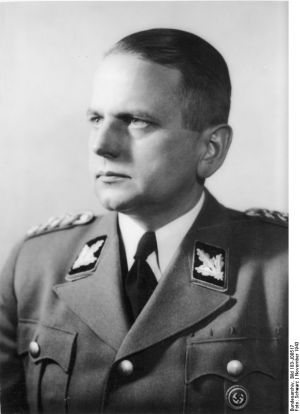Otto Ohlendorf

Otto Ohlendorf
Otto Ohlendorf was born on 4 February 1907 in Hoheneggelsen, the son of a peasant. He was educated at a humanistic Gymnasium in Hildesheim, he later studied law at the Universities of Leipzig and Göttingen, graduating in July 1933. In October 1933 he became assistant to Professor Jessen at the Institute of World Economy at the University of Kiel. He specialised n the study of National Socialism and Italian fascism – he was subsequently the only top SS leader to be familiar with the syndicalist elements and organisational structure of fascist Italy. In January 1935 Otto Ohlendorf became departmental head at the Institute of Applied Economic Science before entering the Sicherheitdienst (SD) the Security Service arm of the SS, and working under Professor Höhn in the following year.
Alongside his promising academic career, the intelligent, idealistic Ohlendorf was active in the National Socialist Students’ League in Kiel and Göttingen as well as teaching at the NSDAP Party School in Berlin in 1935. He had been one of the first members of the newly constituted NSDAP on 28 May 1925, joining the SS on the same date and also fulfilling various SA duties in his home district. The highly educated lawyer and economist was promoted to Major in the SD in 1938 and the following year he was appointed as head of Amt III of the Reich Main Security Office (RSHA), a position he retained until the end of the Second World War. Ohlendorf’s security services provided intelligence information of a unique kind in the Third Reich, prying into the lives and thoughts of ordinary citizens throughout Nazi Germany and acting as a secret and relatively candid recorder of ‘public opinion’ for the benefit of the leadership. Although Ohlendorf’s research workers were secret police agents, his activities were much disliked by Himmler, who characterised the SD chief as ‘an unbearable Prussian, without humour, defeatist and anti-
When Himmler organised his special Einsatzgruppen (extermination units) for service in the Soviet Union, Ohlendorf bureaucratic career was interrupted; from June 1941 to June 1942 he was made Commander of Einsatzgruppe D which operated at the extreme southern end of the eastern front. Attached to the Eleventh Army, the academically trained bloodhound and his units in the Ukraine were responsible for the murder of over 90,000 men, women and children, mostly Jews. In contrast to some other Einsatzgruppen commanders, Ohlendorf ordered that several of his men should shoot the victims at the same time, thus avoiding ‘direct personal responsibility’ as he was later to claim at the Nuremberg trial it was ‘psychologically, an immense burden to bear’ for the executioners. As for the mass murder of Jews in Nikolayev, Kherson, in Podolia and the Crimea which his units carried out. Ohlendorf later defended their role in the dock as a historically necessary task to secure lebensraum (living space) for the German Reich in the East. Recalling precedents such as the murder of gypsies in the Thirty Years’ War and even the Biblical Israelites ‘ extirpation of their enemies. Ohlendorf asserted that history would regard his extermination squads as no worse than the ‘press-
Having completed his stint, as an organiser of mass murders, Ohlendorf returned quietly to the Reich Ministry of Economics, where in November 1943 he became the manager of a committee on export trade and a delegate to the Central Planning Board. Ohlendorf was promoted to the rank of SS-
Sources
R.S. Wistrich, Who’s Who in Nazi Germany, published by Routledge, London and New York 1995
French L. MacLean, The Field Men, published by Schiffer Militay History, Atglen PA, 1999.
Photograph – Bundesarchiv
© Holocaust Historical Society 2014

